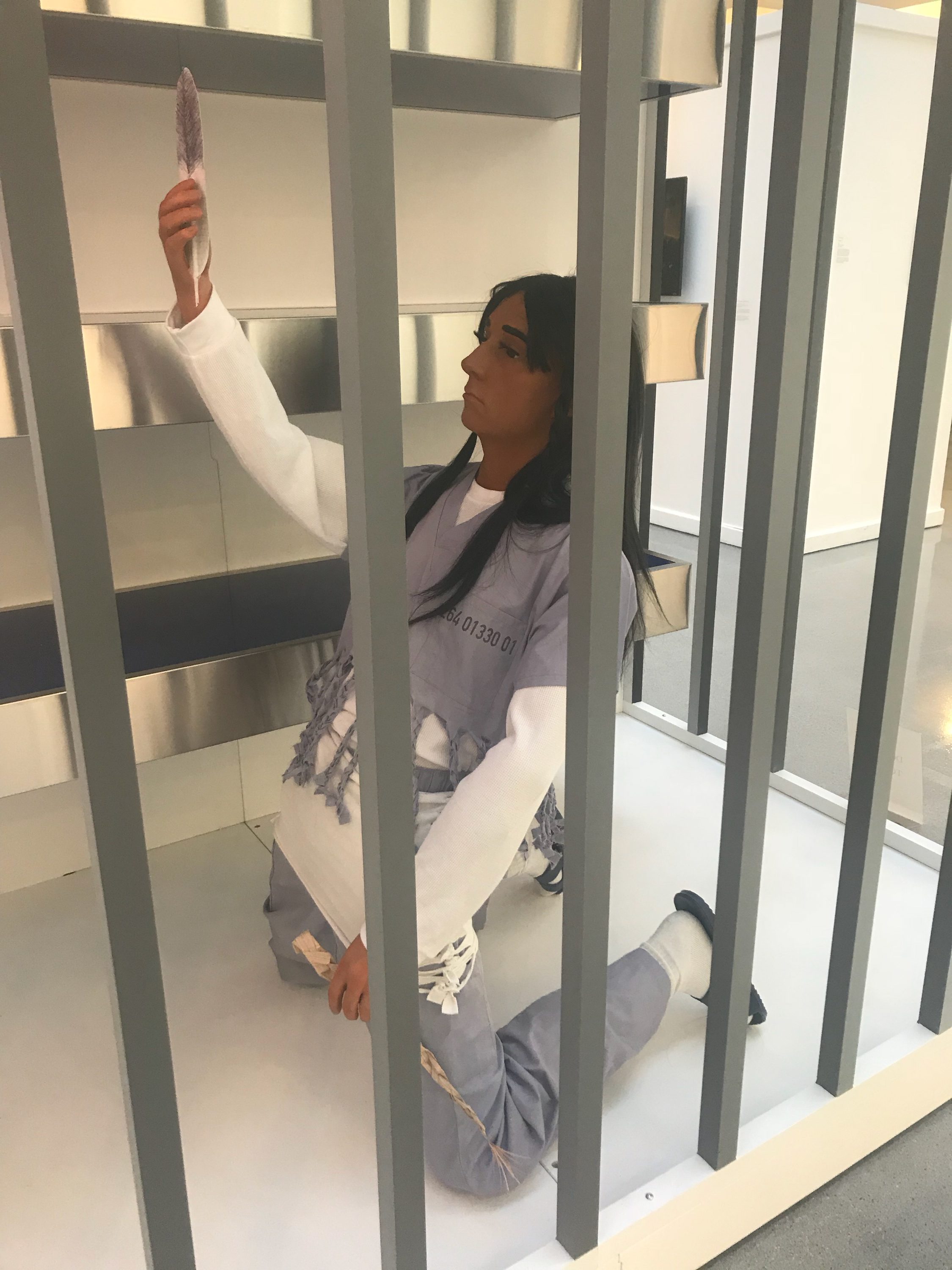The day after I gave a presentation about the Native American occupation of Alcatraz in 1969, I entered Cummings to find an imposing and impactful exhibit that proved the subject of my presentation was more relevant than ever almost 50 years later.
Kent Monkman, a Canadian artist of Cree ancestry, recently installed a multi-dimensional art piece in Cummings that includes sculpture, painting, drawing, and film. At first glance, an observer is struck by a realistic sculpture of a life-sized Native American man in a prison cell. The man has tied and braided the bottom of his blue-grey jumpsuit, wears his hair long and is holding up a crude handmade feather. Bars encourage the viewer to recognize the man’s feelings of entrapment, while the feather and references to Native American culture within the man’s clothes and hair demonstrate the power and resiliency of his heritage. On a deeper level, the piece is a commentary on disproportionate incarceration rates for Indigenous Peoples in the U.S.; Bureau of Justice statistics show that Native Americans are incarcerated at a rate 38% higher than the national average.

Photo courtesy of Lauren Baretta
I spend a lot of time in Cummings, and even after repeated visits, this exhibit has not lost its effect. The center sculpture demands attention. Yet, on closer inspection, paintings on the wall are also equal parts bold and satirical. On Nov. 2, Monkman spoke to a group of students, faculty, staff and guests from multiple Native American tribes across the country. He explained his evolution as an artist highlighting the creation of his alter ego, “Miss Chief,” as a turning point. Miss Chief, a transwoman, challenges patriarchy, gender norms, sexuality, and colonialism. She can be seen in heels and full headdress painting a naked European cowboy in a painting entitled “Artist and Model” or in red lipstick as a nurse in a film depicting the death of modernity.
Though Monkman’s work is often funny, his art is extremely powerful and relevant to the mistreatment of Native Americans even now in 2017. As Monkman put it, “Every place in North America was indigenous land… and Indigenous People still live there often in violence or poverty, but the culture still exists.” He furthered, “Colonialism is still alive and well in our country and it plays itself out daily.”
This brings me to Conn’s role in the fight for Indigenous Peoples’ lands, culture, education, and support. Though Conn has made strides by observing Indigenous Peoples’ Day rather than Columbus Day and bringing in artists like Monkman to highlight the injustices that Native Americans face, the College’s support is tainted with hypocrisy.
Currently, the only way for students to get cash on campus is through the Citizens Bank ATM in Cro. Yet protests over the ethics of the banking giant’s financial investments have rocked the nation from Providence, RI, where Citizens Bank is based, to Washington, D.C., to our own New London. On March 2, 2017, three members of the environmental group, The FANG Collective, chained themselves to the front doors of the local Citizens Bank with bicycle locks and were ultimately charged with disorderly conduct and vandalism.
The FANG Collective, as well as other protest organizations such as Shame on Citizens, are united in the mission to uncover Citizens Bank’s loan history. According to the FANG Collective, Citizens Bank was part of a consortium of financial institutions that collectively provided $2.5 billion of funding to Sunoco Logistics; Citizens made up $72.5 million of this loan. The piece of this puzzle that is concerning is that Sunoco Logistics, a Philadelphia based business, is a subsidiary of Energy Transfer Partners of Dallas. Yes, the same company that is building the Dakota Access Pipeline, the Trans-Pecos Pipeline in Texas, the Mariner East Pipeline in Pennsylvania and the Bayou Bridge Pipeline in Louisiana.
We have all heard the cries from the Standing Rock Sioux Reservation in North Dakota; this protest speaks to the massive injustice perpetrated by Citizens Bank as well as the hypocrisy associated with Conn’s support of the bank. These pipelines are threatening sacred Native American lands. Monkman explained the way that Native American culture has been ignored and erased: “We didn’t want to forget our languages. We didn’t want to forget our culture. We didn’t want to forget where we’re from.” Colonialism has taken enough from Indigenous Peoples. We live and work on stolen lands.
Christopher Soars, Community Learning Coordinator at Conn, first highlighted this contradiction at a CC Divest meeting in mid-October at which President Bergeron; Vice President for Finance and Administration, Rich Madonna; Mayor Passero of New London; and Director of Sustainability at Conn, Margaret Bounds, were all present. CC Divest, a student run club on campus, aims to encourage Conn’s divestment from fossil fuels and other unethical investments.
Soars spoke passionately about his concern regarding Citizens Bank’s support of pipelines, “It’s heart wrenching, it’s heartbreaking. They [Native Americans] are still human beings.” He continued by describing Conn’s relationship with Citizens Bank: “It goes 100% against what CC Divest stands for.” Rich Madonna stated that “we are exploring next steps” and that students who do not support Citizens Bank can choose to use other forms of payment on campus, such as Camel Cash.
I urge that our next steps as a college be immediate and substantial. November is National Native American Heritage Month. Native American people have been lied to, stolen from and cheated and yet still they stand. Still, they produce art that evokes powerful emotion. Still they sing out and speak out against the injustices committed. Conn claims support, but I argue that we need more. An ATM associated with a bank that has helped further fund the systematic oppression of Indigenous Peoples should not greet those that enter Cro. We must support causes with both words and wallets.








